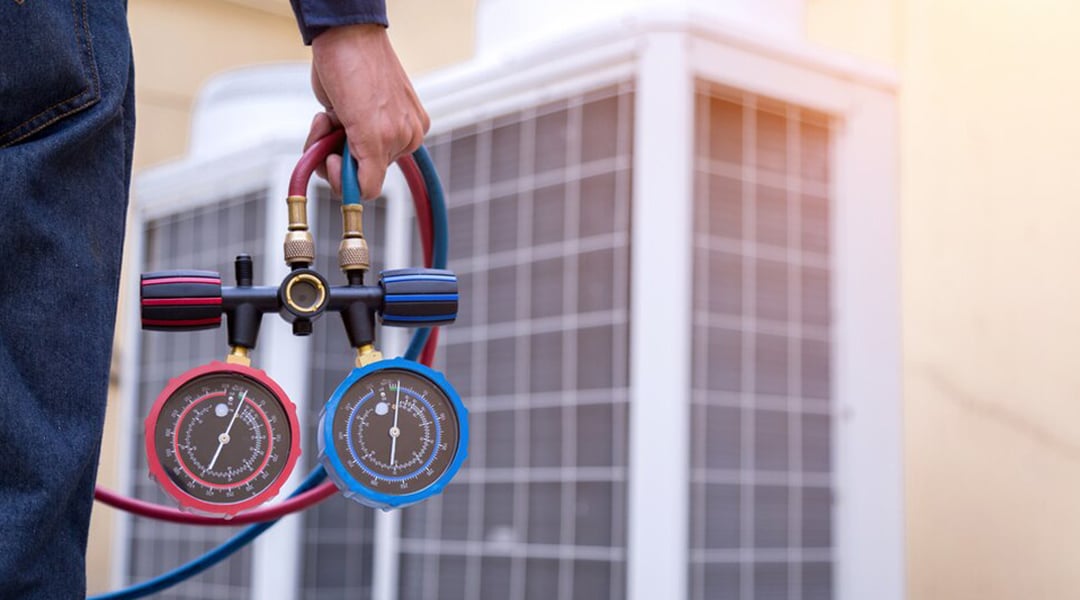-2.png?width=960&height=400&name=MicrosoftTeams-image%20(32)-2.png)
According to Intercoast, the HVAC industry has experienced a substantial growth of 13 percent in recent years, with the upcoming year showing promising prospects. For HVAC technicians, the high demand for their services presents a profitable opportunity to get into entrepreneurship.
Starting your own HVAC business allows you to retain all the profits from the growing market. Even if you don't have a background in HVAC, obtaining certification in a matter of weeks opens the door to starting a business and achieving a comfortable income.
However, the journey of starting a business comes with its challenges. It requires mastering both the ins and outs of the business world and the technical aspects of heaters and air conditioners. Fortunately, IndusTrack has brought a step-by-step guide for you, that serves as a resource, offering the necessary insights to navigate the path of becoming a successful HVAC contractor. So, let’s get started;
.png?width=1080&height=600&name=MicrosoftTeams-image%20(29).png)
Step 1 – Set the Stage by Registering, Licensing, and Insuring Your HVAC Business
Choose a professional, unique, and memorable name for your HVAC Company and register it with your local government. Determine the business structure that best suits your needs:
- If you are a solo entrepreneur in the U.S., consider operating as a sole proprietor (U.S.) for complete control over your business.
- If you are starting an HVAC business with multiple partners, opt for registration as a partnership (U.S.).
- Concerned about liability? Incorporate your business as a limited liability company or LLC (U.S.) to safeguard your personal assets in case of legal issues.
If you operate alone and your business name differs from your personal name, file for a DBA (Doing Business As), also known as an assumed business name or fictitious business name.
Apply for a Business License
All business owners are required to obtain and renew a business license annually to ensure compliance with local laws and regulations. Utilize resources like the U.S. Small Business Administration in the United States to identify the specific permit or license required for your business.
Once you secure a business license, obtaining a business tax number becomes essential, aiding in maintaining compliance and minimizing potential issues during audits.
Safeguard Your HVAC Business with Insurance
Given the risks in HVAC work, it's crucial to invest in the appropriate business insurance to safeguard both your business and your clients. Consult with your insurance provider to tailor coverage based on the HVAC services you provide. Essential types of HVAC business insurance may include general liability insurance, commercial automobile insurance, professional liability insurance, and more.
Read More: Useful HVAC Accounting Tips for Commercial Contractors
Step 2 - Secure Financial Backing for Your HVAC Venture
Initial costs for launching an HVAC business typically range from $3,000 to $12,000, depending on upfront equipment needs. This figure may increase if a vehicle purchase is necessary. Be prepared for various startup expenses, including:
- Acquisition of a van or truck with adequate equipment transport capacity ($15,000–$40,000)
- Everyday HVAC tools such as hammers, step ladders, screwdrivers, tape measures, electrical testers, pliers, wire strippers, and cordless drills ($200–$300)
- Air conditioning and refrigeration tools ($400–$700)
- Personal protective equipment (PPE) and safety gear ($35–$50 per person)
- Business insurance ($600–$2,000)
Once your startup budget is outlined, explore options for business loans or personal loans from your bank.

Craft a Foolproof HVAC Business Plan
Your HVAC business plan is your guide to figuring out how much money you need to kick-start your business and attract support from investors and banks. Make sure your plan covers:
- A Cover Page with your contact details
- An Executive Summary that quickly explains your plan
- A Business Overview that tells why your business exists
- A Financial Plan to show potential investors
- A List of the services you'll provide
- A Market Analysis that looks at your competition
- A Marketing Plan to show how you'll get customers.
Step 3 - Attain Appropriate HVAC Certification
To operate your HVAC business legally, obtaining both an HVAC certification and an HVAC contractor license is usually mandatory. These credentials demonstrate your proficiency in performing safe, high-quality work while adhering to the trade standards specific to your region.
Enroll in an HVAC Certification Program
Prior to becoming an HVAC technician, it is essential to complete an HVAC certification program offered by an accredited school or institution.
In the United States, HVAC technicians servicing air conditioning and refrigeration equipment must obtain Environmental Protection Agency (EPA) certification as mandated by the Clean Air Act.
While not mandatory, obtaining a certificate from reputable organizations such as North American Technician Excellence or HVAC Excellence can enhance your qualifications and instill confidence in your clients regarding your skills.
Step 4 – Create Your Services List & Strategically Price Them
Determine the range of HVAC services you intend to offer and then set competitive prices. If you specialized in a particular service during your trade school training, consider making it a focal point of your business.
To enhance job satisfaction, focus on services you excel at and enjoy performing. Explore various pricing strategies suitable for HVAC jobs:
- Hourly Rate: Utilize hourly rates to maximize profits on labor-intensive tasks or larger commercial HVAC contracts. This approach is particularly beneficial when the duration of a job is uncertain.
- Flat Rate: Implement flat rate pricing to establish a consistent and predictable cost for the entire HVAC job. This strategy is effective when you have a clear understanding of the time required for the task, such as setting a fixed rate of $325 for an air conditioning repair job.
- Labor and Materials Pricing: For installations, adopt a pricing model based on labor hours and the materials supplied. This method simplifies the process of covering your operational expenses while ensuring fair compensation for your services.
Read More: Real-World Field Service Management Survey
Step 5 – Acquire HVAC Tools and Equipment
Now that you have a clear understanding of your chosen HVAC services, it's time to identify and procure the necessary equipment. Here is a list of essential HVAC tools that should be part of your toolkit:
- Fundamental Hand Tools: Include screwdrivers, wrenches, pliers, hammers, gauges, metal and tubing cutters, and staple guns in your arsenal for basic tasks.
- Safety Tools and Personal Protective Equipment (PPE): Prioritize safety with essential gear such as gloves, masks, goggles, and earplugs to ensure a secure working environment.
- Advanced HVAC Tools: Tailor your toolkit based on the specific services you offer. Consider acquiring tools like core removal tools, thermal image cameras, leak detectors, megohmmeters, phase testers, and refrigerant scales to enhance the efficiency and precision of your work.
-2.png?width=1080&height=600&name=MicrosoftTeams-image%20(31)-2.png)
For new HVAC contractors, a typical investment ranges from $200 to $300 for basic tools and safety equipment. The expenditure on advanced tools will vary depending on the nature of the services you plan to provide.
But wait! Keeping track of your tools and equipment is equally important. You can use IndusTrack’s tools tracking feature. How?
- Create a barcode or a QR code for every tool and scan it to add to the inventory.
- Techs can scan the tool, add it to the job and the warehouse people can scan it back to the warehouse.
- Keep track of tools' location, at the warehouse or at the job site, and know who last checked it out.
- Run reports for tools to know the detailed usage history, including tech's details for scanning in or out.
Read More: What an Inventory Management Software Can Do for Your HVAC Business?
Step 6 – Market Your HVAC Business Effectively
Successfully promoting your HVAC business is crucial for acquiring your initial customers and ensuring long-term success. Take the following steps to implement effective HVAC marketing:
- Establish an Online Presence: Create a digital footprint by setting up an online platform for your business. Optimize your website with HVAC SEO (search engine optimization) to ensure visibility when local customers search for HVAC services.
- Door-to-Door Marketing: Leverage the power of word-of-mouth by engaging in door-to-door marketing efforts. Generate initial HVAC leads by personally reaching out to potential customers in your neighborhood and leaving tear-away flyers.
- Utilize HVAC Customer Relationship Management (CRM) Software: Invest in HVAC CRM software to streamline customer information management. This software consolidates essential customer details in one centralized location, eliminating the need to sift through disorganized spreadsheets or notepads. A CRM system is essential for sustainable business growth, preventing overwhelm as your HVAC business expands.
Start a Successful HVAC Business that LASTS
To create a growing HVAC business, make a smart plan and talk to financial experts. They'll help you start your new business right! If you want your HVAC business to make money fast, use the best HVAC software to help you succeed.



